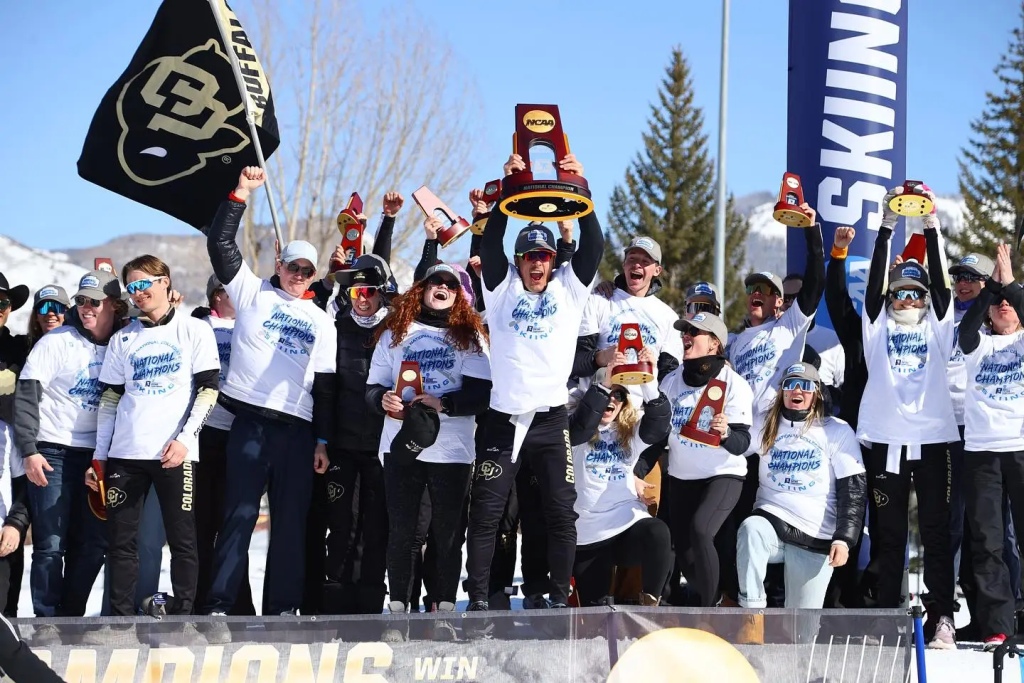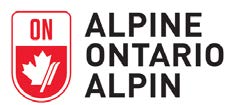
University Racing Programs Overview
Athletes entering University have the option of continuing to race in select Canadian Universities and competing in the annual University Championships in Canada.
Or attending American Universities on the NCAA circuit.
Canadian University Skiing

Canadian University Ski Racing stands as a dynamic platform within the skiing pathway and provides a unique avenue for personal and athletic growth. These university teams offer a competitive pathway that has become an integral part of the collegiate experience for countless student-racers across the country, offering a blend of high-level competition and a sense of community.
One of the distinctive features of the Canadian University programs is their emphasis on balancing academic pursuits with athletic endeavors. Student-athletes participating in this circuit not only strive for podium finishes but also pursue their degrees at a variety of renowned academic institutions in Canada. The circuit encourages a holistic approach to student life, fostering time management skills, discipline, and a strong work ethic that will serve participants well in their future endeavors.
The benefits of engaging in the Canadian University Ski circuit extend beyond the individual athlete. The sense of camaraderie forged on the slopes creates lasting bonds as athletes also compete as part of a team, contributing to an overall team score against other universities. University racing exists under the FIS, and in Canada, the racers compete within Canadian FIS races. Select races within the calendar year are designated as university scored events (particularly in Quebec), and a Canadian University Championships brings teams from across the country together for a final. University programs differ in the level of programming offered. Some focus on provincial FIS circuits, while others support racing at the Nor-Am level for athletes looking at higher-level competitions.
US College Skiing

Collegiate ski racing represents the peak of competition for many junior ski athletes. Competitors race both as individuals and as part of a team, all working toward the ultimate goal of becoming national champions. In the U.S., college ski racing is divided into two main governing bodies: NCAA and USCSA. Both organizations host regular-season division events that lead to regional and national championships. In addition to collegiate races, many athletes also participate in FIS, National, and Continental Cup (Nor-Am) level events.
NCAA-affiliated schools run varsity athletic programs in Alpine and cross-country skiing, offering institutional funding, support services, and paid coaching staff. Institutions from Divisions 1, 2, and 3 compete alongside one another throughout the season. NCAA competitions are divided into three regions: East, Central (Nordic Only), and West. The Eastern Intercollegiate Ski Association (EISA) oversees the eastern region, and the Rocky Mountain Intercollegiate Ski Association (RMISA) governs the western region. For further details or to connect with specific schools, visit the EISA or RMISA websites or see the chart below. Many NCAA athletes also bring experience from Continental Cup or FIS-level races. Athletic scholarships may be available to standout athletes.
USCSA schools offer both varsity and club programs in Alpine, Cross Country, Snowboard, Freeskiing, and Nordic Jumping. Some programs receive school funding and support, and coaching staff may be either paid or volunteer-based. Schools of various sizes compete together during the season. Athletes at USCSA institutions may also have prior experience at the FIS or National level. Certain schools offer athletic scholarships to USCSA participants, and most programs receive backing from either the Athletic Department or the Club Recreation Office.
USCSA competition is structured into 11 regional conferences across the country, which are then grouped into six regions for the purpose of qualifying for the national championship. Scoring and qualification are based on team results, promoting a greater emphasis on community and team spirit. To learn more or to reach out to schools directly, visit the USCSA website and the Member Schools page listed in the Resources section.
College/University Skiing Options
United States:
NCAA Skiing
- Structure & Competitive Circuits
- EISA (Eastern Intercollegiate Ski Association): Mix of NCAA Divisions I–III — includes schools like Boston College, Dartmouth, Harvard, University of New Hampshire, University of Vermont, Middlebury, etc.
- https://www.eisaskiing.org/
- RMISA (Rocky Mountain Intercollegiate Ski Association): NCAA Divisions I & II schools, e.g. University of Colorado, University of Denver, University of Utah, Alaska Anchorage, Westminster, plus associate club Colorado Mountain College.
- https://www.rmisaskiing.com/
- Guide for the College-Bound Athlete
- Team Scoring & Competition
- NCAA skiing is co‑ed: alpine + nordic combine for team titles at regionals and nationals.
- NCAA Alpine Skiing consists of Giant Slalom and Slalom competition
- RMISA and EISA both award regular-season conference titles as well as individual titles
- A full NCAA championship team consists of 12 athletes (3 alpine women, 3 alpine men, 3 nordic women, 3 alpine men)
- Teams that are unable to qualify a full team for NCAA Championships will struggle to win titles (ex. A team without a nordic program may win the alpine portion but is highly unlikely to ever win a NCAA title)
- Level of Competition & FIS Points
- Tier‑1 (e.g., RMISA D1, Some EISA D1): athletes often have solid Nor‑Am & FIS points, contending at the top levels. (Around the 15-40 FIS point range, will vary year to year and school to school, no official range)
- Tier‑2 (D2 or EISA D3): more diverse point profiles— FIS‑points can range depending on school; D3 can also be competitive depending on school and program
- Some D2 and D3 teams are consistently ranked higher the D1 schools, it varies depending on program and athletes
- You can see previous rankings and champions here: NC Skiing Championship History | NCAA.com , NCAA skiing championships – Wikipedia
- Nor-Am/FIS Racing Opportunities
- All NCAA programs support FIS racing
- Most NCAA programs support Nor-Am Racing, you can expect to see most RMISA teams at these events (especially when they are in the west) as well as top EISA teams (more commonly seen at eastern Nor-Ams, but some will travel)
- Cost of Nor-Am entry and attendance can be covered by schools but this varies school to school.
- World Cup and EC opportunities when granted by national teams are encouraged and supported by NCAA schools.
USCSA: A Complementary (or Alternative) Pathway
- Overview
- Governing body with 140+ colleges and ~5,000 athletes competing in alpine, nordic, freeski, and snowboard.
- Separate from NCAA (do not compete together)
- USCSA – United States Collegiate Ski and Snowboard Association – USCSA – Home
- Includes varsity-funded teams as well as fully club-run, student-led programs—from highly competitive to recreational.
- Competitive Structure
- Divided into 11 regional conferences (Eastern, Rocky Mountain, Midwest, etc.).
- Top-3 individual results per team count toward team score at regionals and nationals.
- A Guide to USCSA Skiing: Keeping Athletes in the Game
- Tier System & FIS Exposure
- Eastern Conference (e.g., UConn, MIT, Clarkson) often includes FIS-sanctioned races.
- Rocky Mountain Conference similarly strong (e.g., Colorado Mesa, Western Colorado).
- Highly competitive USCSA teams often compete in regional FIS races
Canada:
U SPORTS & FISU Pathway:
- Canada’s national university sport body; includes ski teams across schools such as Laval, University of Montréal, University of Calgary and McGill.
- Teams send athletes to FISU World University Games; e.g., 18 skiers (11 alpine, 7 ski cross) selected for 2025 Turin games.
FISU (World University Games) Alpine Skiing
- Held every two years; International Competition for student-athletes (Both NCAA and USports athletes compete)
- Eligibility: ages 17–25 while enrolled in a degree program or recently graduated; national qualifications required
- Canadian selections based on NorAm/CAC circuits and provincial cups, with criteria set by Alpine Canada
- https://alpinecanada.org/uploads/documents/2025_WORLD_UNIVERSITY_GAMES_SELECTION_CRITERIA-_FINAL_EN.pdf
So How Do They All Compare?
| Pathway | Level | Team Type | FIS/Nor-Am Access | Scoring |
| NCAA (EISA) | D1-D3 | Varsity | Regular Access- (UNH, UVM, Dartmouth, Middlebury have Extensive Access—region produces Nor-Am Champions), FISU games (Bianual) |
Team (Men/ Women, Nordic/ Alpine) and Individual Scoring
Compete for NCAA titles |
| NCAA (RMISA) | D1-D2 | Varsity + 1 Associate |
Extensive region produces Nor-Am Champions FISU games (Bianual) |
Team (Men/ Women, Nordic/ Alpine) and Individual Scoring
Compete for NCAA titles |
| USCSA | Club | Varsity/ Club | Varies by Region- FIS access only | Top 3 per team count for points |
| U SPORTS (CAN) | Univ | Varsity | Nor-Am, FIS and NC access, FISU games (biannual) |
- NCAA Tier-1 D1: Colorado, Utah, Denver, Vermont, Dartmouth – full FIS/Nor-Am access; regular NCAA national contenders.
- NCAA Tier-2 D3: Bates, Middlebury, Williams – competitive, often FIS 20–60 range; fewer Nor-Am chances.
- USCSA Varsity Clubs: Colorado Mesa, UConn, Babson – some access to FIS races
- Canadian U SPORTS: Laval, U Montréal, Calgary – top feeders to FISU; strong national-level performance.
NCAA Skiing Program List
| Name of School | Division | Conference/ Circuit | Athletic Scholarships/ Aid (Y/N) | Website |
| Eastern Intercollegiate Ski Association (EISA) | ||||
| Boston College | NCAA D1 | EISA | Y | Skiing – Boston College Athletics |
| Dartmouth College | NCAA D1 | EISA | N | Skiing – Dartmouth College Athletics |
| Harvard University | NCAA D1 | EISA | N | Skiing – Harvard University |
| University of New Hampshire | NCAA D1 | EISA | Y | Skiing – University of New Hampshire Athletics |
| University of Vermont | NCAA D1 | EISA | Y | Skiing – University of Vermont Athletics |
| Saint Michael’s University | NCAA D2 | EISA | Y | 2025 Saint Michael’s College Alpine Skiing Outlook – Saint Michael’s College |
| Bates College | NCAA D3 | EISA | N | Alpine Skiing – Bates College |
| Colby College | NCAA D3 | EISA | Y | Alpine Skiing – Colby College |
| Middlebury College | NCAA D3 | EISA | N | Alpine Skiing – Middlebury College |
| Plymouth State University | NCAA D3 | EISA | Y | Skiing – Plymouth State University |
| St. Lawrence University | NCAA D3 | EISA | N | Alpine Skiing – St. Lawrence University Athletics |
| Williams College | NCAA D3 | EISA | N | Skiing – Williams College |
| Rocky Mountain Intercollegiate Ski Association (RIMSA) | ||||
| University of Colorado (Boulder) | NCAA D1 | RMISA | Y | Skiing – University of Colorado Athletics |
| University of Denver | NCAA D1 | RMISA | Y | Skiing – University of Denver Athletics |
| Montana State University | NCAA D1 | RMISA | Y | Skiing – Montana State University Athletics |
| University of Nevada | NCAA D1 | RMISA | Y | Skiing – University of Nevada Athletics |
| University of Utah | NCAA D1 | RMISA | Y | Skiing – University of Utah Athletics |
| University of Alaska Anchorage | NCAA D2 | RMISA | Y | SKIING | University of Alaska Anchorage |
| Westminster University (Utah) | NCAA D2 | RMISA | Y | Alpine Ski – Westminster University Athletics |
| Colorado Mountain College | Associate Member | RMISA | N | CMC Eagles Ski Team – Colorado Mountain College Athletics |
USCSA – Member Institutions – USCSA – United States Collegiate Ski and Snowboard Association
U Sports Skiing Programs List
| Name of School | Province | Website |
| University of Calgary Dinos | Alberta | Alpine Skiing – University of Calgary Athletics |
| University of Montreal Carabins | Quebec | Accueil – Ski alpin |
| University of Laval Rouge et Or | Quebec | Ski alpin | Rouge et Or de l’Université Laval |
| University of Ottawa | Ontario | Alpine Skiing – Ottawa Gee-Gees |
| Lakehead University | Ontario | LU CC Alpine Ski Team | Facebook |
| McGill University (Pending) | Quebec | McGill alpine ski team – McGill University Athletics |
| Carleton University | Ontario | Category: Alpine Skiing – Go Ravens |
Key Takeaways for Athletes & Families
- Determine your competitive level and FIS points—select NCAA or USCSA accordingly.
- Understand team model: NCAA = varsity (resource-heavy); USCSA = club to varsity gradient.
- Consider regional FIS/Nor-Am access—RMISA/Eastern NCAA & top USCSA regions offer stronger circuits.
- Canadian athletes eyeing FISU: target U SPORTS programs and excel in NorAm/CAC series.
Communicate with the program—Talk to current members of the program you are considering as well as coaches to gather the most accurate and up to date information regarding the program.
